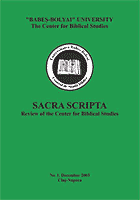The Bible in the Romanian Culture
The Bible in the Romanian Culture
Author(s): Ioan ChirilăSubject(s): Christian Theology and Religion
Published by: Universitatea Babes-Bolyai - Centrul de Studii Biblice
Summary/Abstract: Culture is usually defined as a complex of acts and attitudes generating designation (Umberto Eco), which induce in the social communities certain dispositions of behavior and of information. However, encyclopedias underline the relationship existing between culture and cult. The most exhaustive document which describes this relationship is the Bible. As for many other European cultures, the Bible is the starting point of the literary language for Romanian culture, as well. The first partial translations are the Palia from Orăştie (1582), the New Testament from Bălgrad (1648). The Bible from Bucharest (1688), the Romanian translation of the entire Bible was realized at the initiative and expense of Şerban Cantacuzino, and was published in 1689, during the reign of Constantin Brâncoveanu. The Bible from Bucharest remains a remarkable monument of our old literature, similar in importance to Luther’s Bible translation for German literature. The study deals with the phase following 1688, namely the means through which some texts and some biblical themes have been presented in the Romanian literature and culture. The teachings of Neagoe Basarab to his son, Teodosie, are the most famous monument of Romanian thought and feeling, although it was originally written in Slavic. The chroniclers were also influenced by the Scriptures. Udrişte Năsturel’s first literary work is represented by some verses of homage found in Pravila from Govora, translated by Mihail Moxa. The work O Podrajanii Iisus Hristu (1647), translated from Latin into Slavonic, is in fact a translation of the Imitatio Christi. Another chronicler, Miron Costin is one of the pioneers of Romanian lyrics. He is the first Romanian scholar to write a philosophical poem, The life of the world, inspired by Qohelet. A final part of the study reflects the influence exercised by the Bible on Romanian poetry
Journal: Sacra Scripta
- Issue Year: III/2005
- Issue No: 1+2
- Page Range: 157-173
- Page Count: 17
- Language: English
- Content File-PDF

